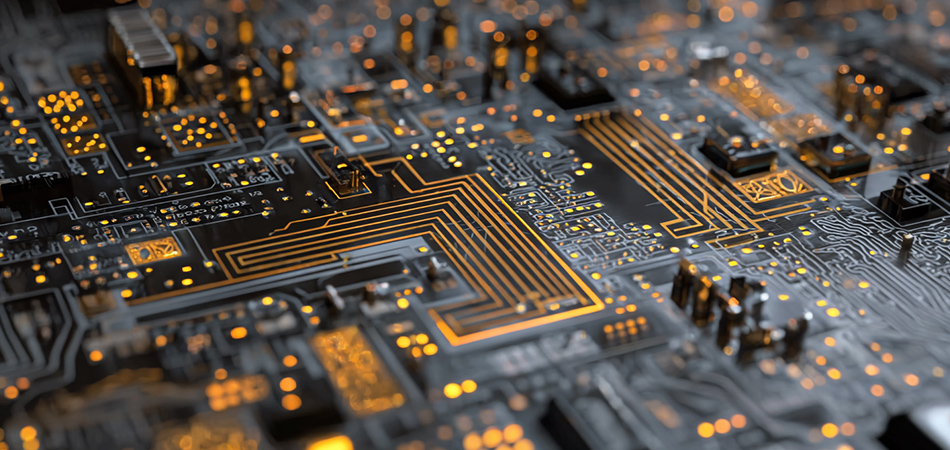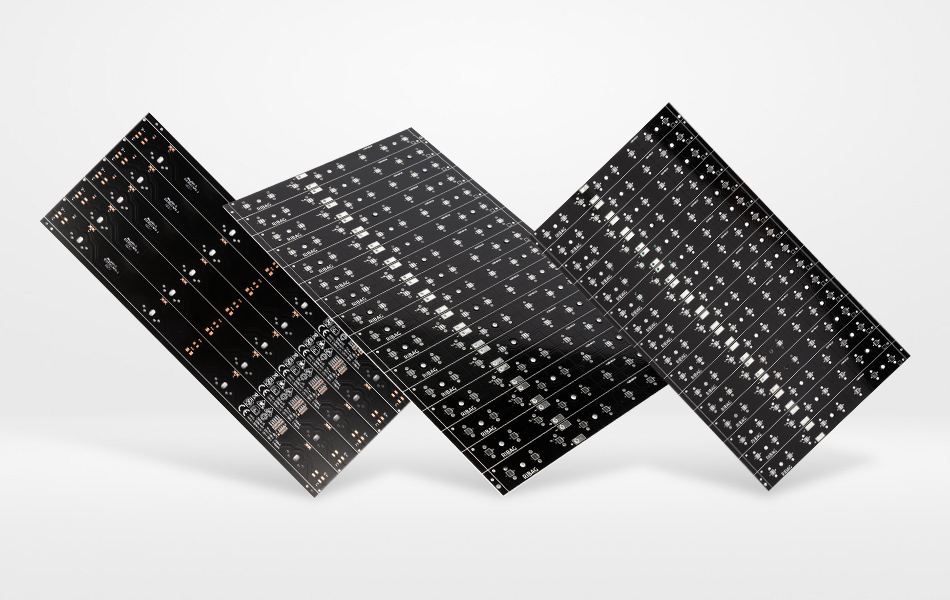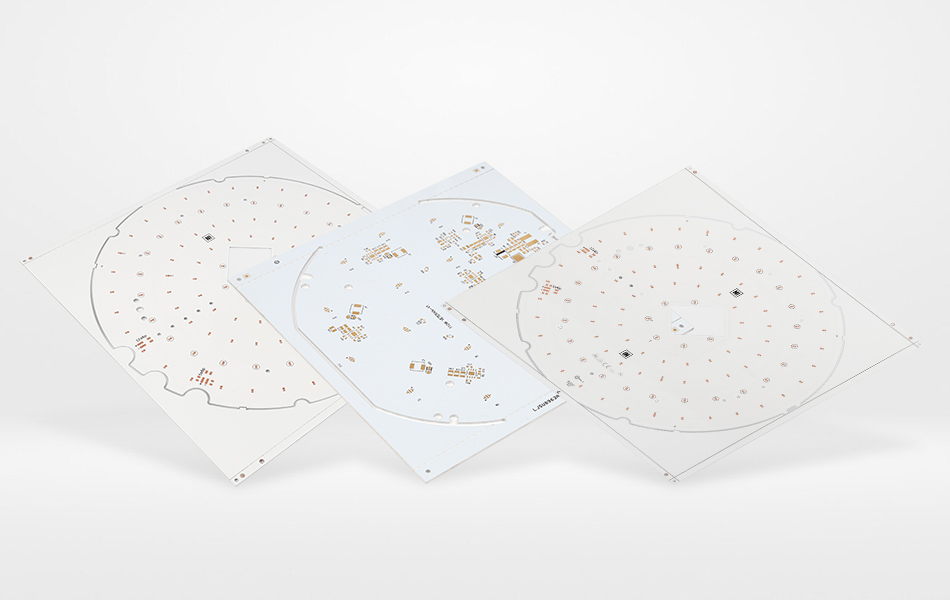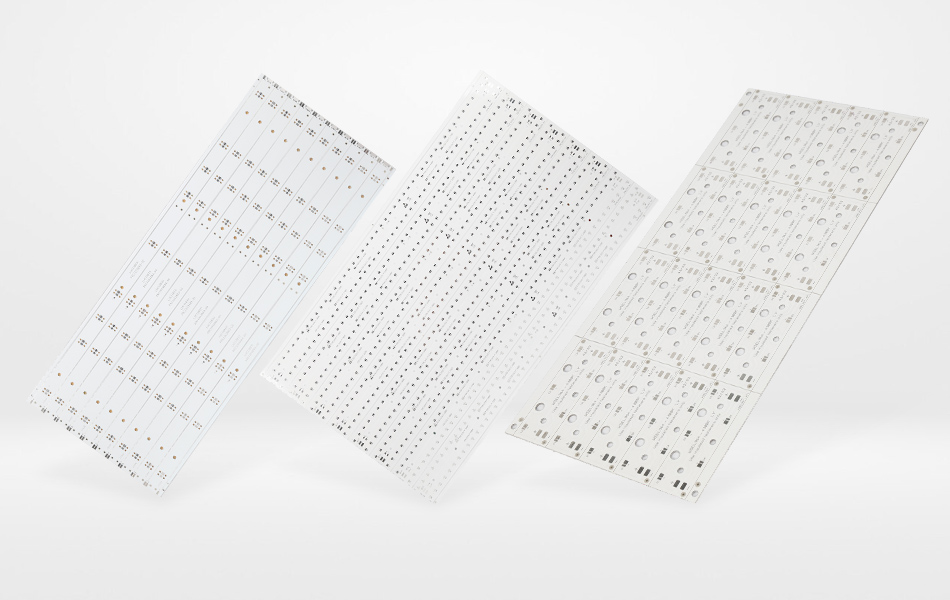-
- PCB TYPE
- PRINTED CIRCUIT BOARD PROTOTYPE ALUMINUM PRINTED CIRCUIT BOARD R&F PCB FPC HIGH FREQUENCY PCB HIGH-TG PCB HEAVY COPPER PCB HDI PCB PCB FOR LIGHTING METAL CORE PCB
time:Jun 20. 2025, 09:20:04
In the ever - evolving realm of electronics, Printed Circuit Boards (PCBs) serve as the silent architects that enable the seamless operation of a plethora of devices. Among the diverse PCB technologies available, Aluminum PCBs have emerged as a revolutionary force, reshaping the way electronics are designed, manufactured, and deployed. Leveraging the unique properties of aluminum, these PCBs offer a compelling combination of thermal management, mechanical robustness, and electrical reliability, making them indispensable in an increasingly wide array of applications. This article will take a deep dive into the world of Aluminum PCBs, exploring their fundamental attributes, design and manufacturing nuances, real - world applications, market dynamics, and the future trends that are set to define their trajectory.
The Core Attributes of Aluminum PCBs
A Foundation of Aluminum
At the heart of every Aluminum PCB lies the aluminum substrate, which acts as the cornerstone of its functionality. Aluminum, a metal renowned for its exceptional properties, brings a multitude of benefits to the PCB table. Its high thermal conductivity allows for rapid heat dissipation, a critical factor in modern electronics where components are constantly pushing the boundaries of power density. By efficiently whisking away heat generated by power - hungry components, Aluminum PCBs prevent thermal bottlenecks that could otherwise lead to performance degradation, component failure, and reduced device lifespan.
Beyond its thermal prowess, aluminum offers remarkable mechanical strength. It can withstand the rigors of various environments, from the vibrations and shocks encountered in automotive and aerospace applications to the mechanical stresses of industrial settings. Simultaneously, its lightweight nature makes it an ideal choice for industries where minimizing the weight of electronic systems is paramount, such as in portable electronics and unmanned aerial vehicles.
The Three - Layer Architecture
Aluminum PCBs typically feature a three - layer architecture. The aluminum substrate forms the base, providing thermal and mechanical support. Above it lies a thermally conductive dielectric layer, a crucial component that strikes a delicate balance. It serves to electrically isolate the aluminum from the electrical traces while facilitating the transfer of heat. This layer is carefully engineered with materials that possess high electrical resistance and good thermal conductivity, ensuring that the PCB can function as a reliable electrical platform while efficiently managing heat.
On the surface, a layer of copper is patterned to create the electrical traces and pads necessary for component mounting and signal transmission. This copper layer, with its excellent electrical conductivity, enables the flow of electrical current and the establishment of connections between components, completing the circuit design.
Synergy of Material Properties
The combination of aluminum, the dielectric layer, and copper results in a PCB that offers a synergy of properties. The thermal conductivity of aluminum, the electrical insulation of the dielectric layer, and the conductivity of copper work in harmony to create a PCB that can handle a wide range of electrical and thermal demands. This synergy not only enhances the performance of the PCB but also enables the development of more compact, powerful, and reliable electronic devices.

Designing Aluminum PCBs: A Delicate Balance
Thermal - Centric Design
Thermal management is at the forefront of designing Aluminum PCBs. Component placement is a critical aspect, as heat - generating components need to be positioned strategically to maximize heat transfer to the aluminum substrate. Placing such components near the edges of the PCB, where there is better air circulation, or adjacent to heat - dissipating elements like heat sinks can significantly enhance heat dissipation. Thermal vias, small holes filled with highly conductive materials, can also be incorporated to create direct pathways for heat to flow from the components to the substrate, further improving thermal performance.
Electrical Design Considerations
In the electrical domain, designing Aluminum PCBs requires careful planning. Trace routing, especially for high - speed signals, demands meticulous attention. The presence of the aluminum substrate can influence the electromagnetic field around the traces, necessitating additional considerations to minimize signal reflections, crosstalk, and interference. Impedance - controlled traces are often employed to ensure consistent signal integrity, and designers must calculate the appropriate impedance values based on factors such as trace width, length, and the dielectric constant of the insulating layer.
Power and ground plane design is also crucial. The aluminum substrate can sometimes be utilized as a ground plane, taking advantage of its low resistance and large surface area. Well - designed power and ground planes help to distribute electrical power evenly, reduce electromagnetic interference (EMI), and provide a stable return path for electrical current, ensuring the reliable operation of the electronic circuits.
Design for Manufacturability
To ensure efficient production, Aluminum PCB designs must also adhere to the principles of design for manufacturability (DFM). Designers need to be aware of the manufacturing capabilities and limitations, such as the minimum trace width and spacing that can be achieved, as well as the ease of component placement and soldering. By optimizing the design for manufacturability, potential production issues can be avoided, production costs can be reduced, and lead times can be shortened.

The Manufacturing Journey of Aluminum PCBs
Material Selection: The First Step
The manufacturing process of Aluminum PCBs begins with the careful selection of materials. High - quality aluminum sheets with consistent thickness and purity are sourced for the substrate. The copper foil for the traces is chosen based on its electrical conductivity and surface quality, ensuring reliable electrical connections. The thermally conductive dielectric material is selected for its electrical insulation properties, thermal conductivity, and adhesion to both the aluminum and copper layers, as it plays a vital role in the overall performance of the PCB.
Lamination: Bonding the Layers
Lamination is a critical step where the aluminum substrate, dielectric layer, and copper foil are bonded together. Heat and pressure are applied to cure the dielectric material, creating a strong and cohesive structure. Precise control of lamination parameters, including temperature, pressure, and time, is essential to ensure a uniform bond and avoid defects such as voids, delaminations, or uneven bonding. Any imperfections in the lamination process can have a significant impact on the thermal and electrical performance of the final PCB.
Drilling and Plating: Creating Connections
After lamination, drilling is performed to create holes for vias, component mounting, and electrical connections. High - precision drilling machines are used to ensure accurate hole placement and clean hole walls. Following drilling, the holes are plated with copper to create electrical connections between the different layers of the PCB and to provide a solderable surface for component attachment. The plating process, typically electroplating, requires careful control of parameters such as current density, plating time, and temperature to achieve a uniform and reliable copper deposit.
Circuit Patterning: Shaping the Circuits
Circuit patterning is the process of creating the electrical circuits on the copper layer. Photolithography is commonly employed for this purpose. A photosensitive resist material is applied to the copper surface, and then a patterned mask is used to expose the resist to ultraviolet (UV) light. The exposed areas of the resist are chemically altered and removed during the development process, leaving the unexposed resist in the shape of the circuit pattern. The remaining copper is then etched away using an etching solution, leaving only the copper traces that form the electrical circuits.

Diverse Applications of Aluminum PCBs
Illuminating the World: LED Lighting
Aluminum PCBs have become the go - to choice for LED lighting applications. LEDs generate a significant amount of heat during operation, and efficient heat dissipation is crucial for maintaining their luminous efficiency and lifespan. Aluminum PCBs can effectively manage this heat, allowing for the design of more powerful and compact LED lighting fixtures. From indoor lighting solutions that create comfortable living and working environments to outdoor streetlights that illuminate our cities, Aluminum PCBs play a vital role in the LED lighting ecosystem.
Powering the Future: Power Electronics
In the realm of power electronics, Aluminum PCBs are widely utilized in applications such as power supplies, inverters, and motor drives. These applications involve high - power components that generate substantial heat and require reliable electrical connections. The aluminum substrate in the PCB helps to dissipate the heat effectively, ensuring the stable operation of the power electronics devices. The low resistance of the copper layer also contributes to efficient power transfer, reducing power losses during conversion and distribution, making Aluminum PCBs essential for power - intensive applications.
Driving Innovation: Automotive Electronics
The automotive industry has embraced Aluminum PCBs for a variety of applications. In modern vehicles, there is a proliferation of electronic systems, including engine control units (ECUs), advanced driver - assistance systems (ADAS), and infotainment systems. Aluminum PCBs are used in these systems due to their ability to withstand the harsh conditions inside a vehicle, such as high temperatures, vibrations, and electromagnetic interference. Their thermal management capabilities ensure that components operate within safe temperature ranges, while their mechanical strength provides durability during vehicle operation.
Reaching for the Skies: Aerospace and Defense
Aerospace and defense applications demand PCBs that can perform reliably in extreme environments. Aluminum PCBs meet these stringent requirements with their high thermal conductivity, mechanical strength, and lightweight properties. They are used in aircraft avionics systems, satellite communication equipment, and military electronics, where the ability to dissipate heat effectively, withstand mechanical stress, and maintain electrical performance is critical for mission success.
Empowering Consumers: Consumer Electronics
In the consumer electronics market, Aluminum PCBs are finding increasing use in devices such as smartphones, tablets, laptops, and gaming consoles. These devices often have power - hungry components that generate a significant amount of heat. Aluminum PCBs help to manage this heat, preventing performance throttling and extending the lifespan of the components. Their lightweight nature also contributes to the design of more portable and sleek consumer electronics products, enhancing the user experience.

Navigating the Market for Aluminum PCBs
Market Growth: A Rising Tide
The global market for Aluminum PCBs has been experiencing robust growth in recent years, and this trend is expected to continue. The increasing demand for energy - efficient lighting solutions, the growth of the automotive and aerospace industries, and the continuous innovation in consumer electronics are all driving factors behind this growth. As more industries recognize the benefits of Aluminum PCBs in terms of performance, reliability, and cost - effectiveness, the market is poised for further expansion.
Competitive Landscape: A Battle for Supremacy
The market for Aluminum PCBs is highly competitive, with numerous manufacturers vying for market share. Key players in the market include both established PCB manufacturers with a long - standing reputation and emerging companies that are bringing new technologies and innovative approaches to the table. Competition is fierce, and manufacturers are constantly striving to differentiate themselves through factors such as product quality, performance, cost - effectiveness, technological innovation, and customer service.

Challenges and the Road Ahead
Challenges on the Horizon
Despite their many advantages, Aluminum PCBs face several challenges. One of the main challenges is the cost. The use of high - quality materials and specialized manufacturing processes can result in relatively high production costs. Fluctuations in the prices of raw materials, such as aluminum and copper, can also impact the cost - effectiveness of production. Additionally, as electronics continue to evolve towards smaller form factors and higher levels of integration, the design and manufacturing of Aluminum PCBs become more complex, requiring more advanced design tools and skilled engineers.
Future Trends: Shaping the Future
The future of Aluminum PCBs is filled with exciting possibilities. Advancements in materials science are expected to lead to the development of new aluminum alloys and composite materials with enhanced thermal and mechanical properties, further improving the performance of Aluminum PCBs. The integration of emerging technologies, such as 5G, the Internet of Things (IoT), and artificial intelligence (AI), will create new opportunities for these PCBs in applications that require high - speed data transfer, efficient power management, and intelligent thermal control.
The adoption of advanced manufacturing technologies, such as additive manufacturing and automation, is also set to revolutionize the production of Aluminum PCBs. Additive manufacturing could enable more complex and customized designs, while automation will improve production efficiency, reduce costs, and enhance quality control. Moreover, the growing focus on environmental sustainability will likely drive the development of more eco - friendly manufacturing processes and materials for Aluminum PCBs, making them even more attractive in the market.
Conclusion
Aluminum PCBs have emerged as a game - changing technology in the electronics industry, offering a unique combination of thermal management, mechanical strength, and electrical reliability. Their applications span across a wide range of industries, from lighting and power electronics to automotive, aerospace, and consumer electronics. While facing challenges related to cost and manufacturing complexity, the future of Aluminum PCBs looks bright, with ongoing advancements in materials, manufacturing technologies, and emerging trends offering significant opportunities for growth and innovation. As the electronics industry continues to evolve, Aluminum PCBs will undoubtedly play an increasingly important role in shaping the future of technology.

Got project ready to assembly? Contact us: info@apollopcb.com



We're not around but we still want to hear from you! Leave us a note:

Leave Message to APOLLOPCB
